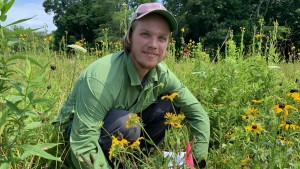This summer, Grant Gerhardt ’25 is conducting research by burying tea bags in a cemetery.
As an Environmental Studies Sustainability Scholar, Gerhardt is working in the Kokosing Nature Preserve — a conservation area, restored prairie, and green burial site. Alongside Assistant Professor of Environmental Studies Lauren Schmitt, he is studying the stages of ecological recovery post-burial — in part by using the decomposition properties of tea — and is beginning to assess how green burial may work as a conservation tool.
A green burial differs from a traditional burial in that the body is placed directly into the ground (often in a shroud or another biodegradable container or casket) without the embalming or vault. The prairie’s recovery at the nature preserve may inform future restoration work in similar landscapes, as well as guide management and practices within the Kokosing Nature Preserve moving forward, Gerhardt explained.
One of Gerhardt’s goals this summer is to investigate the rate of decomposition in the soil across burial sites of different ages using the “Tea Bag Index” method. With this process, two tea bags are buried in each plot — one green tea and one rooibos tea — which decompose at different rates. Later, Gerhardt will retrieve, dry and weigh the bags. The leftover tea matter will reflect the decomposition rate of organic matter in the soil.
This is important because, though green burial sites are considered more eco-friendly than traditional cemeteries, little has been studied about their practical effects on the soil and the plant and insect communities that repopulate the landscape.
Schmitt explained that the amount of time since burial likely impacts the cycling of nutrients into the soil in the immediate area. Gerhardt is comparing the plots to find potential differences in the soil processes of decomposition and nutrient cycling between newer and older burial sites. He will look at variation in the decomposition at burial plots in the period between the initial soil disturbance for the burial and the later years once the prairie has had time to recover.
Gerhardt’s other aims include comparing plant diversity and insect presence between Quarry Chapel Cemetery, a traditional burial ground in Gambier; the Kokosing Nature Preserve; and a traditional restored prairie at the Brown Family Environmental Center. He set up sticky cards at each site to catch and identify insects present, and took a visual inventory of the plants in the area. Gerhardt will assess the plant communities, ground cover, and diversity at each site to compare the ecosystems and determine their ecological similarities and differences.
As an environmental studies major from Cincinnati, Gerhardt said this research experience has been helpful in many ways. He learned to develop concrete methodologies, establish achievable objectives, troubleshoot in the field, and navigate research in study sites that are both beautiful natural prairie and final resting places. “It does really feel like ‘my project,’ which is really exciting,” he said.
Death is a sensitive subject. Prior to the study, families with plots in the nature preserve received a letter detailing the research, and 15 elected to participate. Gerhardt chooses his words carefully when discussing his scientific work with the loved ones of those who are buried here. However, he finds the topic of green burial beautiful and has been excited to build his research around it.
“How I think about it (green burial) is returning to nature in a way,” Gerhardt said. “If it were me in the ground and someone was doing research over top of where I was buried, I would find that so cool.”
Gerhardt finds working in such a landscape poetic as it holds emotional significance for the community and exhibits resilience and natural beauty in its recovery. As Gerhardt crouches down to study the plants he catalogs, it is easy to forget where he is. The prairie offers a subtle reminder of its role as a burial ground in the engraved stone markers, 3-inches tall and hidden beneath tall grasses and flowers swaying gently in the breeze.
This article was written by Isabella Clark ’25 as part of the Hoskins Frame Summer Science Writing Scholars program.
